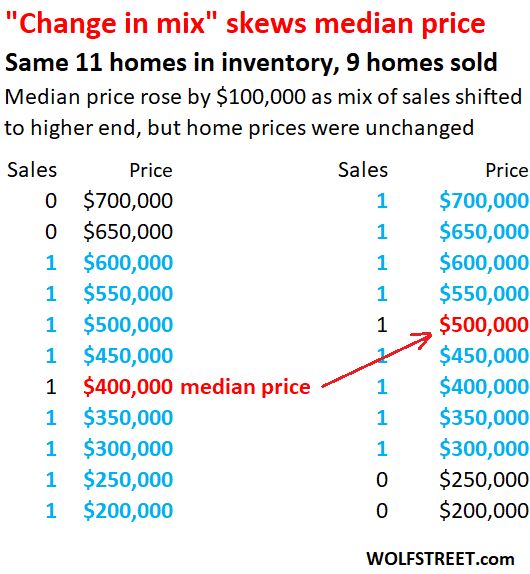Proportionately more sales of higher-end homes and fewer sales of lower-end homes drive up the median Price, even if Actual Prices don’t change.
“Home sales changed little overall, but the upper-end market is experiencing a sizable gain due to more supply coming onto the market,” the National Association of Realtors pointed out in its report that particular month. It said that:
- Inventory of homes for sale of over $1,000,000: +34% year-over-year.
- The “median price” (the price in the middle) was $410,000
- Total sales were roughly unchanged year-over-year.
- Sales of homes of $750,000-$1,000,000: +24% year-over-year
- Sales of homes of over $1,000,000: +40% year-over-year
- Proportionally fewer homes sold in the mid- and lower-range.
That’s what the change in mix looked like in that particular month. There was a big shift toward the higher end and the very high of what actually sold, with proportionally fewer mid-range and lower-end homes selling.
This shift in the mix of what sold drove up the median price.
To illustrate the principle of how a change in the mix skews the median price, we look at our illustration market where 11 homes were in inventory at the beginning of the month, 9 of which then sold.
The median price is the price in the middle of those 9 homes that sold. To get the median price, we make a list of the 9 homes in order of price: The price of the fifth home from the top (or fifth home from the bottom) is the price in the middle = median price.
In the left column, the bottom nine homes sold (blue), and the top two (black) didn’t sell. The median price is the price in the middle of the 9 homes that sold: $400,000.
In the right column, we see the same homes, same prices, but the top two higher-end homes sold, while the bottom two didn’t sell. So this shift in mix shifted the price in the middle (median price) up to $500,000.

In other words, the median price jumped by 100,000 though the actual home prices didn’t change. This is one of the infamous shortcomings of median prices — that they’re skewed by changes in the mix.
The same occurs the other way around: The median price is skewed lower by an increase in sales of lower-end homes and decrease in sales of higher-end homes, even if actual prices don’t change.
Home price data based on median prices are to be enjoyed with a lot of prudence for that reason.
